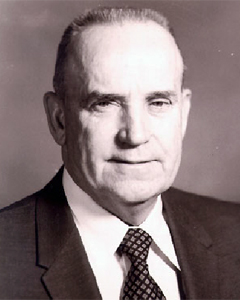Dr. Frank E. Grubbs
 Frank E. Grubbs began his military career
as a field artillery lieutenant in the United States Army Reserve. In 1941, armed with advanced degrees in
electrical engineering and mathematical statistics, he entered active duty and transferred to the Ordnance
Department.
Frank E. Grubbs began his military career
as a field artillery lieutenant in the United States Army Reserve. In 1941, armed with advanced degrees in
electrical engineering and mathematical statistics, he entered active duty and transferred to the Ordnance
Department.
Following completion of training at the Ordnance School, he was assigned to the Ballistics Research Laboratory (BRL) at Aberdeen Proving Ground as a Ballistics Officer. When he was promoted to captain in 1942, he was appointed Chief of BRL's Surveillance Laboratory. Although he returned to the Army Reserve as a lieutenant colonel in 1947, he continued to serve in this position as a Department of Army civilian until 1954. During his tenure at the Surveillance Laboratory, he earned his Ph.D. in mathematical statistics and guided the laboratory's efforts in evaluating the reliability and ballistic characteristics of projectiles, rockets, and guided missiles.
Indicative of his contributions to World War II, he was dispatched to England in 1944 as part of a team on a priority mission to sample and sort the artillery ammunition stockpiled for the invasion of France. After the team conducted thousands of test firings of the hundreds of different lots of artillery ammunition in the stockpiles, he analyzed the statistical variations in the data and was able to divide the ammunition into four large categories based on their ballistic characteristics. As a result, the firing batteries did not need to register each lot of ammunition before it was unpacked; they only needed to apply four sets of ballistic corrections to the firing tables to achieve their objectives.
From 1954 to 1962, he served as Chief of BRL's Weapons Systems Laboratory and was a pioneer in applying operations research techniques to determine the characteristics and performance criteria desirable in improved weapons systems.
In 1962, he became BRL's Associate Technical Director and, from 1966 to 1968, simultaneously served as Director of the Army Materiel Systems Analysis Center (AMSAC), which was organized under BRL to perform independent studies of systems in more than one commodity area. From 1968 to 1972, he was the Chief Operations Research Analyst for the US Army Aberdeen Research and Development Center. In this capacity, he functioned as the senior scientific advisor on matters relating to operations research, systems analysis, probability, and mathematical statistics.
In 1972, he was appointed Chief Operations Research Analyst for the entire US Army Ballistics Research Laboratory and functioned as main scientific advisor to the Director, each of the laboratory chiefs and other Army agencies involved in operations research, systems analysis and related fields.
Dr. Grubbs retired in 1975 with 34 years of service. His contributions to the Army and the Ordnance Corps include more than 80 professional articles and publications. He died in January 2000.